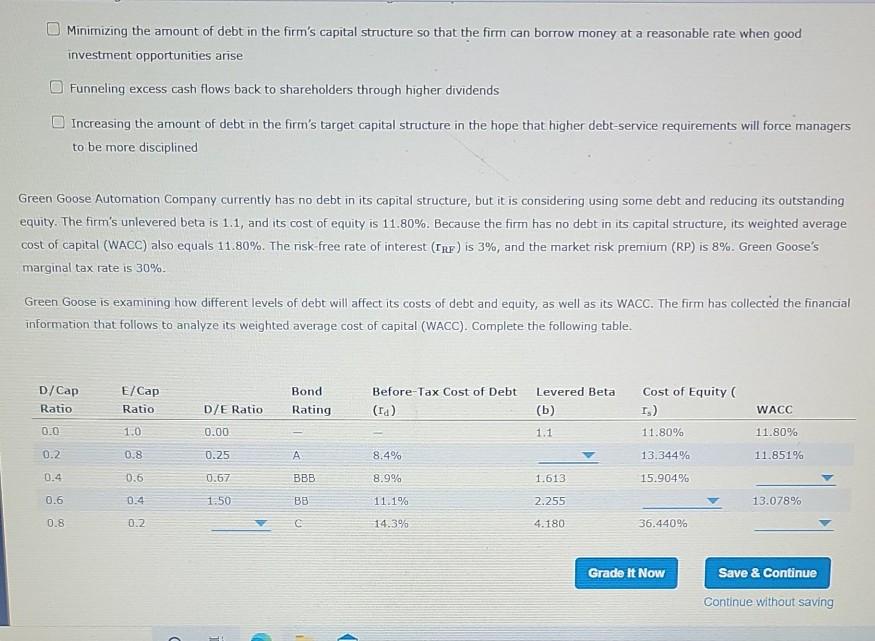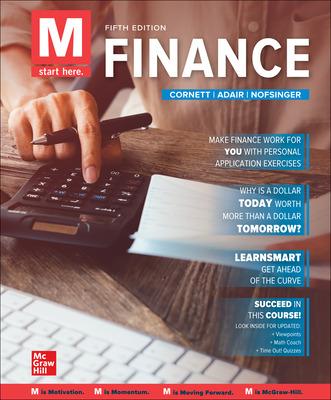Answered step by step
Verified Expert Solution
Question
1 Approved Answer
Options for D/E Ration 3.600 4.400 4.200 4.00 Options for Levered Beta 1.358 1.487 1.552 1.293 Options for Cost of Equity 21.040% 17.884% 26.300% 22.092%


Options for D/E Ration 3.600 4.400 4.200 4.00 Options for Levered Beta 1.358 1.487 1.552 1.293 Options for Cost of Equity 21.040% 17.884% 26.300% 22.092% Options for first WACC drop down 13.839% 15.043% 15.644% 12.034% Options for second WACC drop down 15.296% 17.590% 13.766% 11.472%
Attempts Keep the Highest/2 5. The relationship between a firm's capital structure and othercompany attributes Which of the following are ways that a firm can reduce cash flows in order to prevent managers from wastefully spending excess cash flows? Check all that apply. Funneling excess cash flows back to shareholders through stock repurchases Minimizing the amount of debt in the firm's capital structure so that the firm can borrow money at a reasonable rate when good investment opportunities arise Funneling excess cash flows back to shareholders through higher dividends increasing the amount of debt in the firm's target capital structure in the hope that higher debt-service requirements will force managers to be more disciplined Green Goose Automation Company currently has no debt in its capital structure, but it is considering using some debt and reducing its outstanding equity. The firm's unlevered beta is 1.1, and its cost of equity is 11.80%. Because the firm has no debt in its capital structure, its weighted average cost of capital (WACC) also equals 11.80%. The risk-free rate of interest (TRF) is 3%, and the market risk premium (RP) is 8%. Green Goose's marginal tax rate is 30% Green Goose is examining how different levels of debt will affect its costs of debt and equity, as well as its WACC. The firm has collected the financial information that follows to analyze its weighted average cost of capital (WACC). Complete the following table Dicap Ratio E/Cap Ratio Bond Rating Before-Tax Cost of Debt (1) Levered Beta (b) D/E Ratio Cost of Equity ) 11,80 WACC DO 10 0.00 1.1 11.800 Minimizing the amount of debt in the firm's capital structure so that the firm can borrow money at a reasonable rate when good investment opportunities arise Funneling excess cash flows back to shareholders through higher dividends Increasing the amount of debt in the firm's target capital structure in the hope that higher debt-service requirements will force managers to be more disciplined Green Goose Automation Company currently has no debt in its capital structure, but it is considering using some debt and reducing its outstanding equity. The firm's unlevered beta is 1.1, and its cost of equity is 11.80%. Because the firm has no debt in its capital structure, its weighted average cost of capital (WACC) also equals 11.80%. The risk-free rate of interest (TRF) is 3%, and the market risk premium (RP) is 8%. Green Goose's marginal tax rate is 30% Green Goose is examining how different levels of debt will affect its costs of debt and equity, as well as its WACC. The firm has collected the financial information that follows to analyze its weighted average cost of capital (WACC). Complete the following table. D/Cap Ratio E/Cap Ratio Cost of Equity Bond Rating Before-Tax Cost of Debt (ra) Levered Beta (b) D/E Ratio WACC 0.0 1.0 0.00 1.1 11.80% 11.80% 0.2 0.8 0.25 A 8.4% 13.344% 11.851% 0.4 0.6 0.67 BBB 8.9% 1.613 15.904% 0.6 0.4 1.50 BB 11.1% 2.255 13.078% 0.8 0.2 14.3% 4.180 36.440% Grade It Now Save & Continue Continue without savingStep by Step Solution
There are 3 Steps involved in it
Step: 1

Get Instant Access to Expert-Tailored Solutions
See step-by-step solutions with expert insights and AI powered tools for academic success
Step: 2

Step: 3

Ace Your Homework with AI
Get the answers you need in no time with our AI-driven, step-by-step assistance
Get Started


